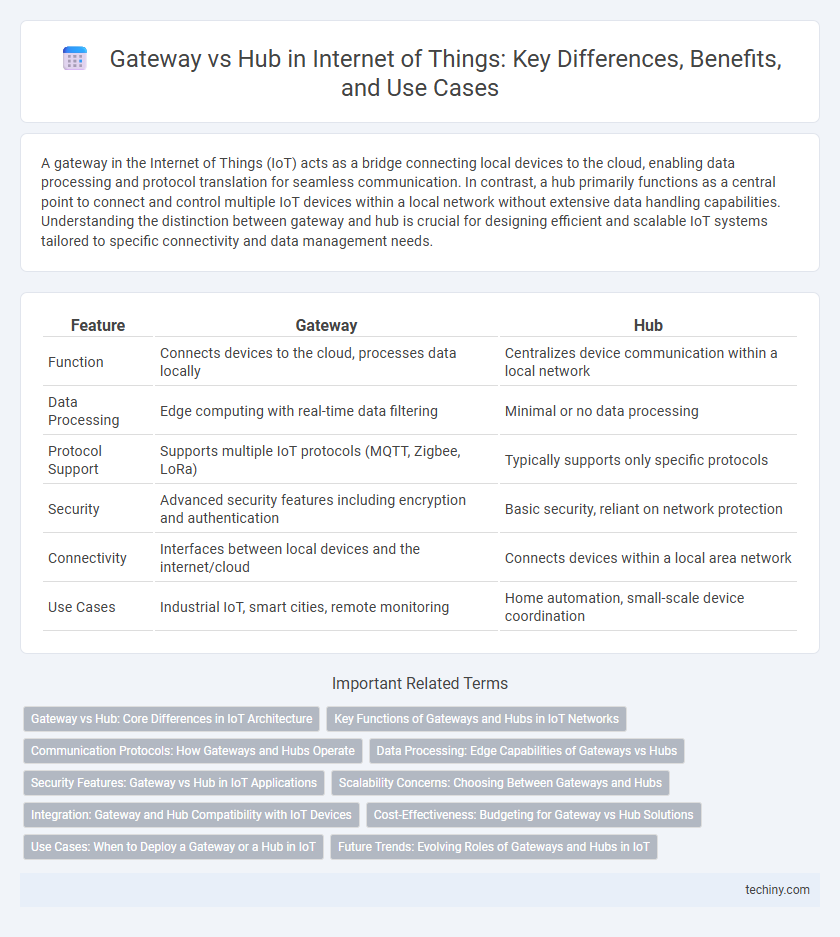A gateway in the Internet of Things (IoT) acts as a bridge connecting local devices to the cloud, enabling data processing and protocol translation for seamless communication. In contrast, a hub primarily functions as a central point to connect and control multiple IoT devices within a local network without extensive data handling capabilities. Understanding the distinction between gateway and hub is crucial for designing efficient and scalable IoT systems tailored to specific connectivity and data management needs.
Table of Comparison
| Feature | Gateway | Hub |
|---|---|---|
| Function | Connects devices to the cloud, processes data locally | Centralizes device communication within a local network |
| Data Processing | Edge computing with real-time data filtering | Minimal or no data processing |
| Protocol Support | Supports multiple IoT protocols (MQTT, Zigbee, LoRa) | Typically supports only specific protocols |
| Security | Advanced security features including encryption and authentication | Basic security, reliant on network protection |
| Connectivity | Interfaces between local devices and the internet/cloud | Connects devices within a local area network |
| Use Cases | Industrial IoT, smart cities, remote monitoring | Home automation, small-scale device coordination |
Gateway vs Hub: Core Differences in IoT Architecture
Gateways in IoT architecture serve as critical nodes that enable communication between edge devices and cloud platforms by managing data processing, protocol translation, and security functions. In contrast, hubs primarily function as simple connection points that aggregate and distribute data within local networks without extensive data processing or protocol handling. The core difference lies in gateways offering advanced interoperability and data management capabilities essential for scalable IoT deployments, whereas hubs provide basic device aggregation with limited processing intelligence.
Key Functions of Gateways and Hubs in IoT Networks
Gateways in IoT networks serve as critical bridges that connect different protocols and enable secure data transmission between edge devices and cloud platforms. Hubs primarily function as centralized devices that aggregate and manage data traffic within local networks, facilitating device interoperability. The gateway's role extends to data processing, filtering, and protocol translation, while hubs focus on network organization and communication efficiency.
Communication Protocols: How Gateways and Hubs Operate
Gateways and hubs differ in their communication protocols, with gateways supporting multiple protocols such as MQTT, CoAP, and HTTP to enable seamless device interoperability and secure data transmission across diverse IoT networks. Hubs typically rely on a single protocol like Zigbee or Z-Wave, primarily focusing on local device management and simple command relays within a confined ecosystem. Gateways perform protocol translation and data processing, enhancing network scalability and integration, whereas hubs function as centralized controllers without extensive data manipulation capabilities.
Data Processing: Edge Capabilities of Gateways vs Hubs
Gateways process data locally at the edge, enabling real-time analytics and reducing latency by filtering and aggregating information before transmitting it to the cloud. Hubs primarily serve as simple communication bridges, forwarding raw data from connected IoT devices without significant local processing. Edge capabilities in gateways enhance network efficiency and support complex decision-making directly within IoT infrastructures.
Security Features: Gateway vs Hub in IoT Applications
IoT gateways provide advanced security features including data encryption, firewall integration, and secure device authentication, ensuring robust protection for sensitive information transmitted between devices and the cloud. Hubs typically offer basic security measures, focusing on device connectivity rather than comprehensive threat defense, leaving potential vulnerabilities unaddressed in complex IoT ecosystems. Gateways often support firmware updates and intrusion detection systems, enhancing ongoing security management critical for large-scale IoT deployments.
Scalability Concerns: Choosing Between Gateways and Hubs
Gateways offer superior scalability compared to hubs by managing data traffic from multiple IoT devices while enabling protocol translation and edge computing capabilities. Hubs typically function as simple connection points, limiting the number of devices and complexity they can support in large IoT networks. For expansive and evolving IoT environments, gateways provide enhanced flexibility and performance by accommodating diverse device types and increased data loads.
Integration: Gateway and Hub Compatibility with IoT Devices
Gateways support a broader range of communication protocols such as MQTT, HTTP, Zigbee, and Z-Wave, enabling seamless integration with diverse IoT devices across different ecosystems. Hubs typically function within a specific protocol or brand ecosystem, offering streamlined yet limited compatibility tailored to particular smart home or industrial setups. The flexibility of gateways allows for centralized device management and data processing, whereas hubs prioritize ease of use and device interconnectivity within a confined network.
Cost-Effectiveness: Budgeting for Gateway vs Hub Solutions
Gateways typically involve higher upfront costs due to their advanced processing capabilities and security features, yet they offer long-term savings by efficiently managing complex IoT networks and reducing data transmission expenses. Hubs, being simpler and less expensive initially, suit small-scale IoT setups but may incur higher costs over time from limited scalability and increased manual management. Evaluating total cost of ownership reveals gateways as more cost-effective for expansive, data-intensive applications, while hubs fit constrained budgets with lower initial investment.
Use Cases: When to Deploy a Gateway or a Hub in IoT
Gateways are essential in IoT deployments requiring protocol translation, edge computing, and secure data transmission between heterogeneous devices and cloud platforms, commonly used in industrial automation and smart cities. Hubs serve well in simpler, localized environments like smart homes or small office setups where multiple devices from the same ecosystem need basic management and communication without intensive processing. Choosing between a gateway and a hub depends on the complexity of device integration, data processing needs, and security requirements within the specific IoT use case.
Future Trends: Evolving Roles of Gateways and Hubs in IoT
Gateways are increasingly integrating edge computing capabilities to process data locally, reducing latency and bandwidth consumption in IoT networks. Hubs are evolving from simple device aggregators to intelligent intermediaries that enable seamless interoperability across diverse protocols and ecosystems. Future trends indicate a convergence where gateways and hubs will collaboratively enhance security, scalability, and real-time decision-making in complex IoT architectures.
Gateway vs Hub Infographic

 techiny.com
techiny.com